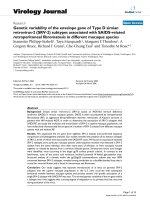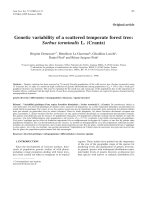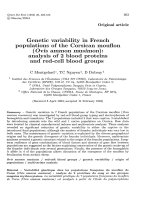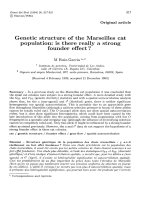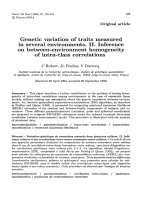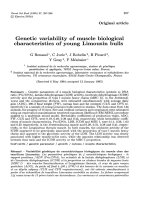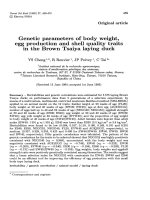Báo cáo sinh học: "Genetic variability of age and weight at puberty, ovulation rate and embryo survival in gilts and relations with production traits" pot
Bạn đang xem bản rút gọn của tài liệu. Xem và tải ngay bản đầy đủ của tài liệu tại đây (789.35 KB, 13 trang )
Original
article
Genetic
variability
of
age
and
weight
at
puberty,
ovulation
rate
and
embryo
survival
in
gilts
and
relations
with
production
traits
JP
Bidanel
J
Gruand
C
Legault
1
Station
de
génétique quantitative
et
appliquée,
Centre
de
recherche
de
Jouy-en-Josas,
Institut
national
de
la
recherche
agronomique,
78352
Jouy-en-Josas
cedex;
2
Station
expérimentale
de
sélection
porcine,
Institut
national
de
la
recherche
agronomique,
86480
Rouillé,
France
(Received
12
January
1995;
accepted
21
September
1995)
Summary -
Age
(AFE),
weight
(WFE)
and
ovulation
rate
(OR)
at
first
estrus,
number
of
embryos
(NE)
and
embryo
survival
(ES
=
NE/OR)
at
30
days
of
gestation
of
French
Large
White
(LW),
French
Landrace
(LF)
and
crossbred
LW
x
LF
gilts
and
their
genetic
relationships
with
average
daily
gain
between
30
and
85
kg
(ADG)
and
average
backfat
thickness
at
85
kg
(ABT)
were
analyzed.
Breed
differences,
as
well
as
genetic
parameters
in
the
LW
breed,
were
estimated
using
a
restricted
maximum
likelihood
procedure
applied
to
a
multiple
trait
animal
model.
A
total
of
3
664
male
and
female
pigs
were
measured
for
ADG
and
ABT
between
1966
and
1979;
1 919
gilts
were
checked
daily
for
puberty
between
140
and
300
days
of
age.
Most
females
were
then
bred
and
slaughtered
at
30
days
of
gestation
for
measuring
the
number
of
corpora
lutea
and
the
number
of
embryos.
Breed
marginal
means
were,
respectively,
214.9 !
1.4,
197.8 !
3.3
and
190.1 !
2.1
days
for
AFE,
116.1 ± 0.9,
102.5 ±
2.2
and
97.7 ±
1.4
kg
for
WFE,
14.4 ±
0.1,
13.0
0.3
and
13.9 ±
0.2
for
OR
and
9.6 !
0.1,
9.6
f
0.4
and
10.5 !
0.3
for
NE
in
LW,
LF
and
LW
x
LF
gilts.
Heritability
estimates
were
0.29,
0.51, 0.27,
0.14
and
0.08
(se
0.03),
respectively,
for
AFE,
WFE,
OR,
NE
and
ES.
Genetic
correlations
between
AFE
and
WFE,
between
NE
and
OR
or
ES
were
rather
large
(0.84
0 . 05 , 0 . 73 +
0.12
and
0.79 !
0.15
respectively).
OR
and
ES
had
a
low
genetic
correlation
(-0.11 ::I:
0.15).
AFE
was
negatively
correlated
with
ADG
(-0.18 !
0.05),
ABT
(-0.21 !
0.05),
OR
(-0.36
f
0.09)
and
NE
(-0.35 !
0.08).
WFE
also
tended
to
be
negatively
correlated
with
OR
(-0.26
t
0.11)
and
NE
(-0.18 !
0.10),
but
exhibited
low
or
positive
genetic
correlations
with
ABT
(0.08 !
0.05)
and
ADG
(0.34 !
0.05).
OR,
NE
and
ES
had
low
or
favourable
genetic
correlations
with
both
ADG
and
ABT.
pig
/
genetic
parameter
/
puberty
/ production
trait
/
reproduction
trait
Résumé -
Variabilité
génétique
de
l’âge
et
du
poids
à
la
puberté,
du
taux
d’ovulation
et
de
la
mortalité
embryonnaire
chez
la
cochette.
Relations
avec
les
caractères
de
production
et
de
reproduction.
L’âge
(APO),
le
poids
(PPO)
et
le
taux
d’ovulation
(TO)
au
premier
cestrus,
le
nombre
d’embryons
(NE)
et
la
survie
embryonnaire
(ES
=
NE/TO)
à
30
jours
de
gestation
de
cochettes
Large
White
(LW),
Landrace
Français
(LF)
et
croisées
LW
x
LF,
ainsi
que
leurs
relations
avec
le
gain
moyen
quotidien
entre
30
et
85 kg
(GMQ)
et
l’épaisseur
moyenne
de
lard
dorsal
à
85
kg
ont
été
analysés.
Les
différences
entre
races,
ainsi
que
les
paramètres
génétiques
de la
race
LW,
ont
été
estimés
à
l’aide
d’une
procédure
du
maximum
de
vraisemblance
restreinte
appliquée
à
un
modèle animal
multicaractère.
Un
total
de
3 664
porcs
mâles
et
femelles
ont
été
mesurés
pour
GMQ
et
ELD
entre
1966
et
1979.
Un
contrôle
quotidien
de
la
puberté
a
été
réalisé
entre
140
et
300
jours
d’âge
sur
un
total
de
1 919
cochettes.
La
plupart
des
femelles
ont
ensuite
été
mises
à
la
reproduction
et
abattues
à
30
jours
de
gestation
afin
de
mesurer
TO
et
NE.
Les
moyennes
marginales
s’élèvent
à,
respectivement,
214,
9 f
1,4 ;
197,
d:
3,
et
190,1 :t
2,1
jours
d’âge
pour
APO,
116,1 !
0,9;
!0!,3 ±
2,2
et
97,7 ± ! !
pour
PPO,
14,4
f
0,1;
13,0 ±
0,3
et
13,9 !
0,2
pour
TO
et
9,6 f
0,1;
9,6 f
0,4
et
10,5 :t
0,3
pour
NE
chez
les
cochettes
LW,
LF
et
LW
x
LF.
Les
estimations
de
l’héritabilité
s’élèvent
à
0,29;
0,51;
0,27;
0,14
et
0,08
(es
0,03),
respectivement,
pour
APO,
PPO,
TO,
NE
et
SE.
Les
corrélations
génétiques
entre
APO
et
PPO,
ainsi
qu’entre
NE
et
TO
ou
SE,
sont
élevées
(respectivement
0,84
::1:
0, 05;
0, 73 +
0,12
et
0, 79 !
0,15).
TO
et
ES sont faiblement
corrélés
(-0,11 :L
0,15).
APO
est
négativement
corrélé
à
GMQ
( - 0, 1 8 +
0,05),
ELD
(-0,21 f
0,05),
TO
(-0,36f
0,11)
et
NE
(—0,! ±
0,08).
PPO
tend
également
à
présenter
des
corrélations
négatives
avec
TO
(-0,26!
0,11)
et
NE
(-0,18!
0,10),
mais
présente
des
corrélations
génétiques
faibles
ou
positives
avec
ELD
(0, 08 ±
0,05)
et
GMQ
(0,34::1:
0,05).
TO,
NE
et
SE
présentent
des
corrélations
génétiques
faibles
ou
favorables
avec
GMQ
et
ELD.
porc
/
paramètre
génétique
/
puberté
/
caractère
de
production
/
caractère
de
reproduction
INTRODUCTION
Until
recently,
pig
breeding
programmes
have
concentrated
on
the
improvement
of
growth
rate,
food
conversion
efficiency
and
carcass
quality
(Ollivier
et
al,
1990).
Little
selection
effort
has
been
devoted
to
reproduction
traits,
ie,
sexual
maturity,
fertility
and
prolificacy.
Litter
size
at
birth
is
the
main
contributor
to
variation
in
sow
reproductive
efficiency
(Tess
et
al,
1983),
but
is
poorly
heritable
and
consequently
rather
difficult
to
improve
through
selection
(Bolet
et
al,
1989).
Johnson
et
al
(1984)
suggested
that
the
rate
of
genetic
improvement
in
litter
size
could
be
increased
by
selecting
on
its
components,
ie,
ovulation
rate
and
prenatal
survival.
Selection
for
ovulation
rate
in
pigs
has
been
effective,
but
without
any
significantly
correlated
response
on
litter
size
(Cunningham
et
al,
1979).
Subsequent
selection
for
litter
size
produced
a
significant
increase
in
litter
size
(Lamberson
et
al,
1991).
This
tends
to
indicate
that
embryo
and/or
fetal
survival
take
a
prominent
part
in
the
variation
of
litter
size
at
birth.
Early
sexual
maturity
of
gilts
is
also
likely
to
have
a
beneficial
influence
on
the
economic
efficiency
of
pig
production.
A
delayed
age
at
puberty
increases
the
length
of
the
unproductive
period
prior
to
first
farrowing
and
complicates
the
management
of
batch
farrowing
systems
(Tess
et
al,
1983;
Rydhmer,
1993).
Moreover,
early
puberty
may
improve
genetic
progress
by
shortening
the
generation
interval
(Hixon
et
al,
1987).
The
value
of
selecting
for
early
puberty
and/or
components
of
litter
size
depends
on
their
genetic
variability
and
genetic
relationships
with
other
economically
important
traits.
The
aim
of
the
present
study
is
to
estimate
breed
differences
and
genetic
parameters
of
age
and
weight
at
first
estrus,
ovulation
rate
and
embryo
survival
and
their
relationships
with
production
traits
in
gilts.
MATERIALS
AND
METHODS
Animals
and
data
collection
The
experiment
took
place
at
the
INRA
experimental
farm
of
RouiII6
(Vienne,
France).
Puberty
traits
were
recorded
on
a
total
of
1393
Large
White
(LW),
110
French
Landrace
(LF)
and
501
LW
x
LF
(LW
sire
and
LF
dam)
gilts
between
1966
and
1979.
LW
gilts
were
produced
in
the
scope
of
a
selection
experiment
for
lean
tissue
growth
rate
(Ollivier,
1977,
1980).
The
design
of
the
experiment,
which
began
in
1965,
is
detailed
by
Ollivier
(1977).
In
March
of
each
year,
all
male
offspring
(except
runt
piglets)
of
the
boars
selected
the
previous
year
and
of
sows
picked
at
random
in
a
LW
population
of
about
5 000
sows
located
in
small
herds
were
grouped
in
the
INRA
experimental
station
of
RouiII6
(Vienne,
France)
and
selected
on
their
performance
test
results
as
described
below.
The
animals
originated
from
a
large
number
of
farms
located
around
the
INRA
experimental
herd,
as
only
one
or
two
litters
were
produced
in
each
herd.
Selected
boars
were
then
placed
in
the
INRA
artificial
insemination
(AI)
center
of
RouiII6
and
their
semen
used
on
sows
from
the
above-mentioned
LW
population
to
produce
the
next
generation.
In
September
of
each
year,
daughters
from
these
AI
boars
were
also
grouped
in
RouiII6
to
study
puberty
and
prolificacy
traits.
It
should
be
noted
that
LW
males
and
females
were
born
at
different
periods
of
time.
Hence,
they
were
either
half-
or
full-sibs,
but
could
not
be
littermates.
Randomly
sampled
contemporary
LF
and
LW
x
LF
females
were
introduced
into
the
herd
in
1971,
1972,
1977
and
1978
to
study
breed
differences.
These
females
also
came
from
a
large
number
of
small
herds.
Crossbred
females
were
generally
daughters
from
the
same
LW
boars
as
LW
gilts.
Their
dams
were
sometimes,
but
not
systematically,
related
to
the
dams
of
LF
gilts.
As
for
males,
all
females
(except
runt
piglets)
from
each
litter
produced
were
grouped
at
the
INRA
experimental
station
for
performance
testing.
Piglets
were
purchased
at
20-25
kg
live
weight
and
allotted
to
pens
of
about
ten
animals
in
a
semiopen
building.
They
were
performance
tested
from
30
to
80
kg,
extended
to
85
kg
from
1977
onwards.
Animals
were
given
ad
libitum
access
to
a
pelleted
diet
in
self
feeders
and
to
water
during
the
whole
test
period.
Then,
gilts
were
given
a
daily
ration
of
feed
averaging
2.5
kg
until
slaughter.
A
preliminary
diet
formulated
to
contain
3.2
Mcal
and
17%
crude
protein/kg
was
fed
until
60
kg
liveweight.
The
energy
and
protein
contents
of
the
diet
were
then
reduced
to
3.0
Mcal
and
15%
crude
protein/kg
until
slaughter.
Animals
were
weighed
at
the
beginning
and
at
the
end
of
the
test
period.
Backfat
thickness
was
measured
at
the
same
time
as
final
weight.
The
ultrasonic
measurements
were
taken
on
each
side
of
the
spine,
4
cm
from
the
mid-dorsal
line
at
the
levels
of
the
shoulder,
the
last
rib
and
the
hip
joint,
respectively.
LW
boar
candidates
were
selected
on
the
basis
of
a
performance
test
index:
I
=
O.OlADG -
0.5ABT
where
ADG
is
average
daily
gain
(in
g)
over
the
test
period
and
ABT
is
the
average
of
the
six
backfat
measurements
(in
mm),
adjusted
for
final
weight.
Puberty
was
defined
as
the
first
estrus,
indicated
by
a
standing
response
to
a
teaser
boar.
Estrus
detection
on
a
daily
basis
was
initiated
when
the
heaviest
gilt
in
a
pen
reached
80
kg
(ie,
at
approximately
140
days
of
age)
and
continued
until
300
days
of
age.
Gilts
were
weighed
when
they
reached
first-detected
estrus
and
immediately
inseminated
(except
in
1967,
1968
and
1971).
They
were
then
slaughtered
27-30
days
after
reaching
first
estrus.
Ovaries
were
dissected
to
count
corpora
lutea
and
embryo
number
recorded
in
pregnant
females.
Females
that
did
not
conceive
were
not
bred
again.
The
ovulation
rate
of
gilts
which
did
not
conceive
at
the
first
estrus
records
were
measured
at
the
second
estrus
and
were
excluded
from
the
analysis.
Similarly,
reproductive
measurements
from
gilts
ovulating
without
any
detectable
estrus
symptoms
and
from
gilts
showing
estrus
symptoms
without
ovulation
were
discarded
from
the
appropriate
data
vectors.
Conversely,
puberty
and
ovulation
rate
records
from
gilts
born
in
1967,
1968
and
1971,
which
were
not
inseminated
but
were
slaughtered
7-13
days
after
puberty,
were
retained
in
the
analyzes.
Seven
traits
were
defined
and
analyzed
from
the
above-mentioned
measurements,
ie,
ADG,
ABT,
age
(AFE)
and
weight
(WFE)
at
first
detectable
estrus,
ovulation
rate
(OR)
estimated
as
the
total
number
of
corpora
lutea,
the
number
of
living
embryos
(NE)
at
30
days
of
gestation
and
embryo
survival
rate
(ES)
defined
as
the
ratio
of
number
of
embryos
to
ovulation
rate.
The
structure
of
the
data
studied
is
shown
in
table
I.
LW
ancestors
were
known
over
the
experiment
on
the
male
side.
Conversely,
the
parents
of
most
dams
and
the
paternal
grandams
were
generally
unknown.
Part
of
these
data
were
previously
analyzed
by
Legault
(1973)
and
Legault
and
Gruand
(1981),
but
genetic
parameter
estimation
was
limited
to
heritabilities.
Statistical
analyzes
Preliminary
analyzes
showed
that:
i)
most
gilts
reached
puberty
before
300
days
of
age
(95,
98
and
98%
of
animals checked
for
puberty,
respectively,
in
LW,
LF
and
LW
x
LF
populations);
and
ii)
gilts
ovulating
without
any
detectable
estrus
symptoms
and
gilts
showing
estrus
symptoms
without
ovulating
represented
less
than
1%
of
the
total
number
of
gilts.
Hence,
there
was
almost
no
left
or
right
censorship
on
reproductive
traits.
Moreover,
all
traits
except
ES
were
almost
normally
distributed,
(puberty
traits
were
only
slightly
skewed)
so
that
standard
mixed
linear
model
procedures
were
considered
adequate
to
analyze
the
data.
Genetic
and
environmental
parameters
were
estimated
in
the
LW
breed
using
a
derivative-free
restricted
maximum
likelihood
(REML)
procedure
applied
to
a
multiple
trait
individual
animal
model.
The
data
set
was
too
large
to
allow
a
single
seven-trait
REML
analysis.
Hence,
ten
successive
four-trait
analyzes
were
performed.
These
four-trait
analyzes
systematically
included
ADG
and
ABT
in
order
to
account
for
the
effects
of
selection,
plus
two
reproduction
traits
in
order
to
get
estimates
of
the
covariances
between
reproduction
traits
and
between
reproduction
and
production
traits.
The
model
for
ADG
and
ABT
included
sex
and
year
with
batch
interaction
as
fixed
effects,
with
litter
of
birth
and
animal
fitted
as
random
effects.
The
same
model,
but
without
the
sex
effect,
was
used
for
AFE,
WFE,
OR,
NE
and
ES.
The
analyzes
were
performed
using
version
2.2
of
the
VCE
computer
package
(Groeneveld,
1993).
Approximate
standard
errors
of
variance
components
and
genetic
parameters
were
obtained
from
an
approximation
of
the
Hessian
matrix
when
convergence
was
reached.
Estimates
of
breed
marginal
means
were
computed
using
BLUP
(best
linear
unbiased
prediction;
Henderson,
1973)
methodology
applied
to
an
individual
animal
model.
The
model
was
a
seven-trait
animal
model
including
breed,
year
with
batch
interaction
and
sex
(for
ADG
and
ABT
only)
as
fixed
effects,
with
litter
of
birth
and
animal
fitted
as
random
effects.
The
PEST
computer
package
(Groeneveld
and
Kovac,
1990)
was
used
for
this
purpose.
Genetic
and
environmental
(co)variances
used
were
the
REML
estimates
obtained
in
the
LW
breed.
Variance
estimates
from
univariate
REML
analyzes
on
the
whole
set
of
data
were
similar
to
those
obtained
in
the
LW
breed,
thus
indicating
that
genetic
parameters
did
not
widely
differ
between
genetic
types.
RESULTS
Genetic
type
marginal
means
are
shown
in
table
II.
LW
animals
grew
faster
(+
68 !
12
g/d)
and
were
fatter
(+
2.6 !
0.3
mm
of
backfat
thickness)
than
their
LF
contemporaries.
Crossbred
LW
x
LF
animals
were
intermediate
(deviations
from
purebred
means
were,
respectively,
+
6
t
9 g/day
and
+
0.3 :!:
0.3
mm,
for
ADG
and
ABT).
LW
gilts
were
older
(+
17.1
3.5
days)
and
heavier
at
puberty
(+
13.6 !
1.8
kg)
than
LF
gilts.
They
also
had
more
corpora
lutea
(+
1.3 !
0.3),
but
a
lower
embryo
survival
(- 7.1 ±
2.7)
than
LF
gilts,
so
that
the
number
of
embryos
was
similar
in
both
breeds.
Crossbred
females
had
an
earlier
sexual
maturity
than
both
purebreds.
Deviations
from
purebred
average
performance
were -
16.2 !
2.8
days
and -
11.6 !
1.8
kg,
respectively,
for
AFE
and
WFE.
Crossbred
gilts
were
almost
intermediate
for
OR,
but
had
a
better
embryo
survival
(5.2 !
2.2
%)
and
more
living
embryos
than
purebred
animals
(+ 0.9
t
0.3
embryos).
Several
estimates
of
variance
components
were
available
for
each
trait.
However,
variation
among
estimates
was
very
small
(less
than
1%
between
extreme
values),
so
that
the
average
values
of
heritability
and
common
litter
effect
presented
in
table
III
are
almost
the
same
as
estimates
obtained
in
each
individual
analysis.
Heritability
estimates
of
0.5
for
ABF
and
WFE
were
higher
than
those
for
NE
and
ES
(0.1),
with
intermediate
heritability
estimates
for
ADG,
AFE
and
OR.
Common
environmental
effects
were
equal
to
0.1,
with
high
and
low
estimates
for
ADG
and’
ES,
respectively.
Estimates
of
phenotypic
and
genetic
correlations
are
shown
in
table
IV.
ADG
and
ABT
exhibited
a
slightly
positive,
ie,
unfavourable,
relationship.
Large
positive
phenotypic
and
genetic
correlations
were
obtained
between
AFE
and
WFE.
Simi-
larly,
NE
had
strongly
positive
genetic
correlations
with
both
OR
and
ES,
which
were
poorly
correlated.
was
negatively,
ie,
favourably,
correlated
with
AFE,
but
had
a
positive
genetic
correlation
with
WFE.
Genetic
correlations
between
ADG
and
prolificacy
traits
were
low
or
positive,
ie,
favourable.
ABT
also
tended
to
be
favourably
correlated
with
prolificacy
traits,
but
showed
some
genetic
antagonism
with
AFE.
Puberty
traits
had
negative
genetic
correlations
with
OR
of
NE
and
were
poorly
correlated
with
ES.
DISCUSSION
Estimates
of
the
between-
or
within-breed
genetic
variability
of
sexual
maturity
traits
are
not
very
numerous
in
the
literature.
Moreover,
available
estimates
generally
have
a
low
accuracy.
This
is
likely
due
to
the
fact
that
puberty
attainment
is
very
tedious
to
detect.
However,
the
delayed
puberty
of
LW
gilts
as
compared
to
LF
gilts
and
the
earlier
sexual
maturity
of
crossbred
gilts
as
compared
to
pure
breeds
in
the
present
study
is
in
agreement
with
most
other
results
in
the
literature
(Christenson,
1981;
Hutchens
et
al,
1982;
Legault
and
Caritez,
1983;
Allrich
et
al,
1985;
Irgang
et
al,
1992).
Heterosis
effects
could
not
be
estimated
without
bias
in
this
study
because
the
LW
x
LF
reciprocal
cross
was
lacking,
so
that
heterosis
and
maternal
effects
were
confounded.
However,
maternal
effects
on
age
at
puberty
are
of
limited
importance
(Christenson,
1981;
Allrich
et
al,
1985),
so
that
the
deviation
of
LW
x
LF
from
the
purebred
average
should
be
close
to
heterosis
effects.
Indeed,
the
value
obtained
does
not
differ
much
from
the
literature
average
(—11.3
days;
Bidanel,
1988).
The
larger
OR
of
LW
as
compared
to
LF
and
the
intermediate
position
of
crossbred
LW
x
LF,
as
well
as
the
lack
of
difference
between
purebreds
for
NE
and
the
larger
litter
size
of
LW
x
LF
gilts,
also
agree
with
results
from
the
literature
(see,
for
instance,
the
reviews
of
Bidanel,
1989,
and
Blasco
et
al,
1993a).
Heritability
estimates
for
ADG,
ABT,
age
at
puberty,
OR
and
NE
are
close
to
previous
estimates
of
Legault
and
Gruand
(1981)
and
to
average
literature
values
(Bidanel,
1989;
Lamberson,
1990;
Stewart
and
Schinckel,
1990;
Blasco
et
al,
1993a;
Ducos,
1994).
Conversely,
the
value
obtained
for
weight
at
puberty
is
larger
than
most
literature
estimates
(Young
et
al,
1978;
Hutchens
et
al,
1981).
The
heritability
of ES
is
lower
than
the
values
reported
by
Johnson
et
al
(1984),
Neal
et
al
(1989)
or
Gama
et
al
(1991)
in
synthetic
populations
but,
unlike
Haley
and
Lee
(1992),
tends
to
show
that
some
genetic
variation
for
ES
exists
in
a
LW
population.
Common
litter
effects
(c
2)
tend
to
be
larger
than
usual
literature
values,
particularly
for
ADG
and
ABT.
This
is
probably
due
to
a
partial
confounding
between
birth
litter
and
herd
of
origin
(litters
generally
came
from
different
herds),
both
of
which
have
an
effect
on
growth
performance.
The
strong
genetic
correlation
between
NE
and
ES
agrees
with
the estimates
obtained
in
the
Nebraska
experiment
(Neal
et
al,
1989)
and
with
estimates
obtained
in
mice
and
rabbits
(Clutter
et
al,
1990;
Blasco
et
al,
1993b).
Conversely,
a
much
stronger
association
between
OR
and
NE
and
a
lower
relationship
between
OR
and
ES
than
in
most
other
studies
at
30
days
of
gestation
(Young
et
al,
1977),
50
days
of
gestation
(Neal
et
al,
1989)
or
at
birth
(Young
et
al,
1978)
is
observed.
This
may
be
due
to
differences
in
the
populations
studied,
but
may
also
indicate
that
uterine
competition
tends
to
increase
throughout
gestation.
This
increased
competition
has
been
evidenced
by
superovulation
and
embryo
transfer
experiments
(Dziuk,
1968;
Pope
et
al,
1972;
Webel
and
Dziuk,
1974)
or
more
recently
by
experiments
on
unilaterally
hystero-ovariectomized
females
(Christenson
et
al,
1987;
Legault
et
al,
1995).
Bennett
and
Leymaster
(1989)
proposed
a
model
for
litter
size
with
two
independent
components,
OR
and
uterine
capacity,
defined
as
the
maximum
number
of
fetuses
that
the
uterine
environment
can
support.
In
this
model,
OR
is
uncorrelated
with
ES
and
negatively
correlated
with
fetal
survival.
The
results
from
the
present
study
are
in
fairly
good
agreement
with
this
model,
even
if
the
small
negative
correlation
between
OR
and
ES
might
indicate
that
uterine
capacity
could
also
have
some
effect
during
early
gestation.
Similar
results,
ie,
a
low
correlation
between
OR
and
ES
and
a
much
stronger
one
between
OR
and
fetal
survival,
were
obtained
in
intact
(Blasco
et
al,
1993a)
and
unilaterally
overiectomized
does
(Blasco
et
al,
unpublished
results),
where
a
laparoscopic
technique
makes
it
possible
to
count
rabbit
fetuses
during
gestation
with
no
detectable
impact
on
subsequent
fetal
survival
(Santacreu
et
al,
1990).
The
large
phenotypic
and
genetic
correlations
between
age
and
weight
at
puberty
are
in
close
agreement
with
most
available
literature
estimates
(Reutzel
and
Sumption,
1968;
Young
et
al,
1978;
Hutchens
et
al,
1981).
However,
in
spite
of
their
close
genetic
relationship,
age
and
weight
at
puberty
show
rather
different
correlations
with
growth
rate.
Indeed,
negative
relationships
with
age
at
puberty
and
positive
ones
with
weight
at
puberty
were
obtained
in
all
available
studies
(Reutzel
and
Sumption,
1968;
Young
et
al,
1978,
Hutchens
et
al,
1981,
Rydhmer
et
al,
1992).
This
difference
can
be
explained
by
noting
that
the
correlation
between
growth
rate
and
weight
at
puberty
is
the
result
of
two
antagonistic
relationships,
ie,
a
slight
negative
relationship
between
growth
rate
and
age
at
puberty
and
a
rather
strong
positive
one
between
growth
rate
and
weight
at
a
given
age.
The
relationships
between
puberty
traits
and
backfat
thickness
are
less
clear.
Negative,
ie,
unfavourable,
genetic
correlations
with
age
at
puberty
were
obtained
by
Gama
and
Johnson
(1992),
Rydhmer
et
al
(1992)
and
in
the
present
study.
Conversely,
null
or
positive
correlations
were
reported
by
Young
et
al
(1978),
Hutchens
et
al
(1981)
and
Hixon
et
al
(1987).
These
discrepancies
are
partly
due
to
the
low
accuracy
of
most
estimates
but
may
also,
as
argued
by
Rydhmer
et
al
(1992),
be
due
to
genotype
x
feeding
regime
interactions
between
studies.
The
negative,
ie,
favourable,
genetic
correlations
between
age
at
puberty
and
ovulation
rate
or
number
of
embryos
are
consistent
with
the
estimates
obtained
by
Young
et
al
(1978).
Conversely,
Rydhmer
et
al
(1992)
obtained
positive
genetic
correlations
between
age
at
puberty
and
litter
size
at
birth.
These
discrepancies
may
partly
be
due
to
differences
in
the
traits
analyzed
(litter
size
at
30
days
of
gestation
versus
at
birth).
It
may
also
be
related
to
the
fact
that
litter
size
was
measured
at
a
constant
chronological
age
in
the
study
of
Rydhmer
et
al
(1992),
but
at
a
constant
physiological
age
in
Young
et
al
(1978)
and
in
the
present
study
(second
and
first
estrus,
respectively).
However,
a
negative
correlation
is
more
likely
to
occur
between
age
at
puberty
and
litter
size
at
a
constant
chronological
age
in
young
gilts,
as
prolificacy
increases
with
estrus
number.
Thus
late
maturing
gilts,
which
have
a
lower
estrus
number,
would
tend
to
have
small
litters
(Rydhmer
et
al,
1992).
The
results
of
Despres
et
al
(1992),
who
found
a
decrease
in
age
at
puberty
in
the
so-called
’hyperprolific’
LW
line
selected
for
litter
size
in
France,
also
tend
to
show
that
age
at
puberty
is
negatively
correlated
with
sow
prolificacy.
In
any
case,
results
from
the
present
study
tend
to
indicate
that
selection
for
growth
rate
has
an
opposite
effect
to
selection
against
backfat
thickness
on
age
and
weight
at
puberty
in
the
LW
population
studied.
As
a
consequence,
the
correlated
response
of
sexual
maturity
traits
to
selection
on
an
index
based
on
growth
rate
and
backfat
thickness
will
depend
on
the
relative
emphasis
given
to
each
trait
in
the
selection
index.
A
slight
increase
of
both
age
and
weight
at
puberty
can
be
predicted
from
the
index
used
and
the
genetic
parameter
estimates
from
the
present
study.
Selection
objectives
in
France
have
until
now
put
a
stronger
emphasis
on
carcass
lean
content
than
on
growth
rate.
Hence,
a
delayed
sexual
maturity
may
be
expected
based
on
the
genetic
parameters
of
the
present
study,
provided
that
the
genetic
parameters
obtained
from
these
fairly
old
data
are
still
valid
for
current
pig
populations.
This
delayed
puberty
may
be
accompanied
by
a
reduced
intensity
of
estrus
symptoms,
as
recently
shown
by
Rydhmer
et
al
(1994).
However,
selection
objectives
in
pigs
are
currently
changing
towards
a
lower
emphasis
on
lean
content
and
a
stronger
one
on
growth
rate
and
prolificacy.
A
more
favourable
genetic
trend
for
age
at
puberty
can
be
expected
from
an
increased
economic
weight
of
growth
rate.
Conversely,
the
impact
of
the
growing
economic
weight
of
prolificacy
remains
unclear,
because
its
relationship
with
age
at
puberty
is
not
well
established.
CONCLUSION
This
study
confirms
that
puberty
traits
are
not
genetically
independent
of
produc-
tion
traits
in
gilts.
As
a
consequence,
age
at
puberty
can
be
changed
by
selection
for
growth
rate
or
carcass
lean
content.
Favourable
genetic
trends
can
be
expected
from
selection
for
growth
rate,
but
unfavourable
changes
should
result
from
selec-
tion
for
lean
content.
The
evolution
of
puberty
traits
in
pig
breeding
programs
will
therefore
depend
on
the
relative
emphases
placed
on
these
traits,
but
also
on
other
economically
important
traits
such
as
food
conversion
ratio,
meat
quality
or
prolificacy.
This
study
also
provides
genetic
parameter
estimates
of
components
of
litter
size
at
30
days
of
gestation,
ie,
ovulation
rate
and
embryo
survival.
It
tends
to
confirm
the
existence
of
some
genetic
variation
in
embryo
survival,
which
is
almost
independent
of
genetic
variation
in
ovulation
rate.
REFERENCES
Allrich
RD,
Christenson
RK,
Ford
JJ
(1995)
Age
at
puberty
and
estrous
activity
of
straightbred
and
reciprocal
crossed
gilts.
Anim
Reprod
Sci
8,
281-286
Bennett
GL,
Leymaster
KA
(1989)
Integration
of
ovulation
rate,
potential
embryonic
viability
and
uterine
capacity
into
a
model
of
litter
size in
swine.
J
Anim
Sci
67,
1230-
1241
Bidanel
JP
(1988)
Bases
zootechniques
et
g6n6tiques
de
1’utilisation
en
élevage
intensif
des
races
prolifiques
chinoises -
cas
du
porc
Meishan.
PhD
thesis,
Institut
national
agronomique,
Paris-Grignon,
France
Bidanel
JP
(1989)
Taux
d’ovulation
et
survie
pr6natale
chez
le
porc :
aspects
g6n6tiques.
INRA
Prod
Anim
2,
159-170
Blasco
A,
Bidanel
JP,
Bolet
G,
Haley
CS,
Santacreu
MA
(1993a)
The
genetics
of
prenatal
survival of
pigs
and
rabbits:
a
review.
Livest
Prod
Sci
37,
1-21
Blasco
A,
Santacreu
MA,
Thompson
R,
Haley
CS
(1993b)
Estimates
of
genetic
parameters
for
ovulation
rate,
prenatal
survival
and
litter
size
in
rabbits
from
an
elliptical
selection
experiment.
Livest
Prod
Sci
34, 163-174
Bolet
G,
Ollivier
L,
Dando
P
(1989)
Selection
sur
la
prolificit
6
chez
le
porc.
I.
R6sultats
d’une
experience
de
selection
sur
onze
generations.
Genet
Sel
Evol
21,
93-106
Christenson
RK
(1981)
Influence
of
confinement
and
season
of
the
year
on
puberty
and
estrous
activity
of
gilts.
J
Anim
Sci
52,
821-830
Christenson
RK,
Leymaster
KA,
Young
LD
(1987)
Justification
of
unilateral
hyster-
ectomy-ovariectomy
as
a
model
to
evaluate
uterine
capacity
in
swine.
J
Anim
Sci
65,
738-744
Clutter
AC,
Nielsen
MK,
Johnson
RK
(1990)
Alternative
methods
of
selection
for
litter
size
in
indice.
I.
Characterization
of
base
population
and
development
of
methods.
J
Anim
Sci
68,
3536-3542
Cunningham
PJ,
England
ME,
Young
LD,
Zimmerman
DR
(1979)
Selection
for
ovulation
rate
in
swine:
correlation
response
in
litter
size
and
weight.
J
Anim
Sci
48,
509-516
Despres
P,
Martinat-Bott6
F,
Lagant
H,
Terqui
M,
Legault
C
(1992)
Comparaison
des
performances
de
reproduction
des
truies
appartenant
a
trois
genotypes :
Large
White
(LW),
Large
White
« Hyperprolifique
» (LWH),
Meishav,
(MS).
In:
24
e
Journees
Rech
Porcine
en
Prance,
Paris,
4-6
f6vrier
1990,
Institut
technique
du
porc,
Paris,
25-30
Ducos
A
(1994)
Evaluation
g6n6tique
des
porcs
contr6l6s
dans
les
stations
publiques
à
l’aide
d’un
modèle
animal
multicaract6re.
PhD
Thesis,
Institut
national
agronomique,
Paris-Grignon,
France
Dziuk
PJ
(1968)
Effect
of
number
of
embryos
and
uterine
space
on
embryo
survival
in
the
pig.
J
Anim
Sci
27,
673-676
Gama
LT,
Boldman
KG,
Johnson
RK
(1991)
Estimates
of
genetic
parameters
for
direct
and
maternal
effects
on
embryonic
survival
in
swine.
J
Anim
Sci
69,
4801-4809
Gama
LT,
Johnson
RK
(1992)
Correlated
responses
to
selection
for
prolificacy
or
age
at
puberty
in
pigs.
In:
43rd
Annual
Meeting
of the
EAAP,
Madrid,
Spain,
September
1992,
Commission
on
Animal
Genetics
Groeneveld
E
(1993)
Estimating
(co)variances
for
joint
genetic
evaluations.
In:
Proc
EC
Seminar
on
Application
of
Mixed
Linear Models
in
the
Prediction
of
Genetic
Merit
in
Pigs
(E
Groeneveld,
ed),
IAHAE-FAL,
Mariensee,
Germany,
83-102
Groeneveld
E,
Kovac
M
(1990)
A
generalized
computing
procedure
for
setting
up
and
solving
mixed
linear
models.
J
Dairy
Sci
73,
513-531
Haley
CS,
Lee
GJ
(1992)
Genetic
factors
contributing
to
variation
in
litter
size
in
British
Large
White
gilts.
Livest
Prod
Sci
30,
99-113
Henderson
CR
(1973)
Sire
evaluation
and
genetic
trends.
In:
Proc
Animal
Breeding
and
genetics
Symposium
in
honor
of
Dr
JL
Lush,
American
Society
of
Animal
Science
and
Dairy
Science
Association,
Champaign,
IL,
10-41
Hixon
AL,
Mabry
JW,
Benyshek
LL,
Weaver
WM,
Marks
MA
(1987)
Estimates
of
genetic
parameters
for
sexual
and
compositional
maturity
in
gilts.
J
Anim
Sci
64,
977-982
Hutchens
LK,
Hintz
RL,
Johnson
RK
(1981)
Genetic
and
phenotypic
relationships
between
puberal
and
growth
characteristics
of
gilts.
J
Anim
Sci
53,
946-951
Hutchens
LK,
Hintz
RL,
Johnson
RK
(1982)
Breed
comparisons
for
age
and
weight
at
puberty
in
gilts.
J
Anirn
Sci
55,
60-66
Irgang
R,
Scheid
IR,
Favero
JA,
Wentz
I
(1992)
Daily
gain
and
age
and
weight
at
puberty
in
purebred
and
crossbred
Duroc,
Landrace
and
Large
White
gilts.
Livest
Prod
Sci
32,
31-40
Johnson
RK,
Zimmerman
DR,
Kittok
RJ
(1984)
Selection
for
components
of
reproduction
in
swine. Livest
Prod
Sci
11,
541-558
Lamberson
WR
(1990)
Genetic
parameters
for
reproductive
traits.
In:
Genetics
of Swine
70-76
Lamberson
WR,
Johnson
RK,
Zimmerman
DR,
Long
TE
(1991)
Direct
responses
to
selection
for
increased
litter
size
decreased
age
at
puberty,
or
random
selection
following
selection
for
ovulation
rate
in
swine.
J
Anirn,
Sci
69,
3129-3143
Legault
C
(1973)
D6terminisme
g6n6tique
de
la
precocite
sexuelle,
du
taux
d’ovulation,
et
du
nombre
d’embryons
chez
la
truie
primipare:
heritabilite,
effet
dl
h6t6rosis.
In:
(ý-
Journées
Rech
Porcine
en
France,
Paris,
14-16
fevrier
1973,
Institut
technique
du
porc,
Paris,
347-354
Legault
C,
Gruand
J
(1981)
Effets
additifs
et
non
additifs
des
genes
sur
la
precocite
sexuelle,
le
taux
d’ovulation
et
la
mortalité
embryonnaire
chez
la
jeune
truie.
In:
13e
Journées
Rech
Porcine
en
France,
Paris,
4-5 fevrier
1981,
Institut
technique
du
porc,
Paris,
247-254
Legault
C,
Caritez
JC
(1983)
L’exp6rimentation
sur
le
porc
chinois
en
France.
I.
Perfor-
mances
de
reproduction
en
race
pure
et
en
croisement.
Genet
Sel
Evol 15,
225-240
Legault
C,
Caritez
JC,
Lagant
H,
Popescu
P
(1995)
Étude
exp6rimentale
du
role
de
l’espace
ut6rin
sur
la
viabilite
embryonnaire
et
foetale.
Incidence
du
type
g6n6tique
de
la
mere.
In:
27
e
Journées
Rech
Porcine
en
France,
Paris,
31
janvier-2
f6vrier
1995,
Institut
technique
du
porc,
Paris,
25-30
Neal
SM,
Johnson
RK,
Kittok
RJ
(1989)
Index
selection
for
components
of
litter
size
in
swine:
response
to
five
generations
of
selection.
J
Anim
Sci
67,
1933-1945
Ollivier
L
(1977)
Dix
ans
d’une
experience
de
selection
individuelle
sur
des
verrats
utilises
en
insemination
artificielle.
I.
R6ponses
observ6es
sur
des
caract6res
de
croissance,
de
carcasse
et
de
qualite
de
viande.
Ann
Genet
Sél
Anim
9,
353-377
Ollivier
L
(1980)
Estimated
responses
to
eleven
years
of
boar
selection.
Livest
Prod
Sci
7,
57-66
Ollivier
L,
Gu6blez
R,
Webb
AJ,
Van
Der
Steen
HAM
(1990)
Breeding
goals
for
nationally
and
internationally
operating
pig
breeding
organisations.
In:
4th
World
Congress
on
Genetics
Applied
to
Livestock
Production,
Edinburgh,
23-27
July,
15,
383-394
Pope
CE,
Christenson
RK,
Zimmerman-Pope
VA,
Day
BN
(1972)
Effect
of
number
of
embryos
on
embryonic
survival
in
recipient
gilts.
J
Anim
Sci
35,
805-808
Reutzel
LF,
Sumption
LJ
(1968)
Genetic
and
phenotypic
relationships
involving
age
at
puberty
and
growth
rate
of
gilts.
J
Anim
Sci
27,
27-30
Rydhmer
L
(1993)
Pig
reproductive
genetics
and
correlations
between
reproduction
and
production
traits.
PhD
thesis,
Swedish
University
of
Agricultural
Sciences,
Uppsala,
Sweden
Rydhmer
L,
Johansson
K,
Stern
S,
Eliasson-Selling
L
(1992)
A
genetic
study
of pubertal
age,
litter
traits,
weight
loss
during
lactation
and
relations
to
growth
and
leanness
in
gilts.
Acta
Agric
Scand 42,
211-219
Rydhmer
I,
Eliasson-Selling
L,
Johansson
K,
Stern
S,
Andersson
K
(1994)
A
genetic
study
of
estrus,
symptoms
at
puberty
and
their
relationship
to
growth
and
leanness
in
gilts.
J
Anim
Sci
72,
1964-1970
Santacreu
MA,
Gou
P,
Blasco
A
(1990)
Evaluation
par
coelioscopie
des
corps
jaunes
et
des
embryons.
Influence
sur
la
taille
de
la
port6e
chez
la
lapine.
Reprod
Nutr
Dev
30,
583-588
Stewart
TS,
Schinckel
AP
(1990)
Genetic
parameters
for
swine
growth
and
carcass
traits.
In:
Genetics
of
Swine
(LD
Young,
ed),
USDA,
ARS-MARC,
Clay
Center,
NE,
84-87
Tess
MW,
Bennett
GL,
Dickerson
GE
(1983)
Simulation
of
genetic
changes
in
life
cycle
efficiency
of
pork
production.
II.
Effects
of
components
on
efficiency.
J
Anim
Sci
56,
354-368
Webel
SK,
Dziuk
PJ
(1974)
Effect
of
stage
of
gestation
and
uterine
space
on
prenatal
survival
in
the
pig.
J
Anim
Sci
38,
960-963
Young
LD,
Johnson
RK,
Omtvedt
IT
(1977)
An
analysis
of
the
dependency
structure
between
a
gilt’s
prebreeding
and
reproductive
traits.
1.
Phenotypic
and
genetic
corre-
lations.
J
Anim
Sci
44,
557-564
Young
LD,
Pumfrey
RA,
Cunningham
PJ,
Zimmerman
DR
(1978)
Heritabilities
and
genetic
and
phenotypic
correlations
for
prebreeding
traits,
reproductive
traits
and
principal
components.
J
Anim
Sci
46,
937-949
